Phoenix, Arizona, where mighty rivers go to die.
Phoenix is a giant sandy sponge that soaks up all the fresh water from 5 states. The Salt and Verde rivers bring water from northern Arizona and New Mexico and run dry 30 miles short of Phoenix. The underground aquifers of the Santa Cruz, Gila, Agua Fria and New rivers drift into the Valley of the Sun.
The Colorado River is siphoned into the Central Arizona Project canal, rolls into Phoenix and is promptly dumped on golf courses, pumped underground, or treated and released into buildings and landscape pipes. That water is green and tastes like shit.
While Denver and California restrict water during drought, the Phoenicians build golf courses and fountains and spray shit-tons of water on their front and back lawns like they are raising their children in a fucking rain forest.
That’s right fuckers, you want to see where your water goes, grab a flight to Phoenix. Look down at all the golf couses, lawns, trees, lakes and swimming pools. That’s your river down there.
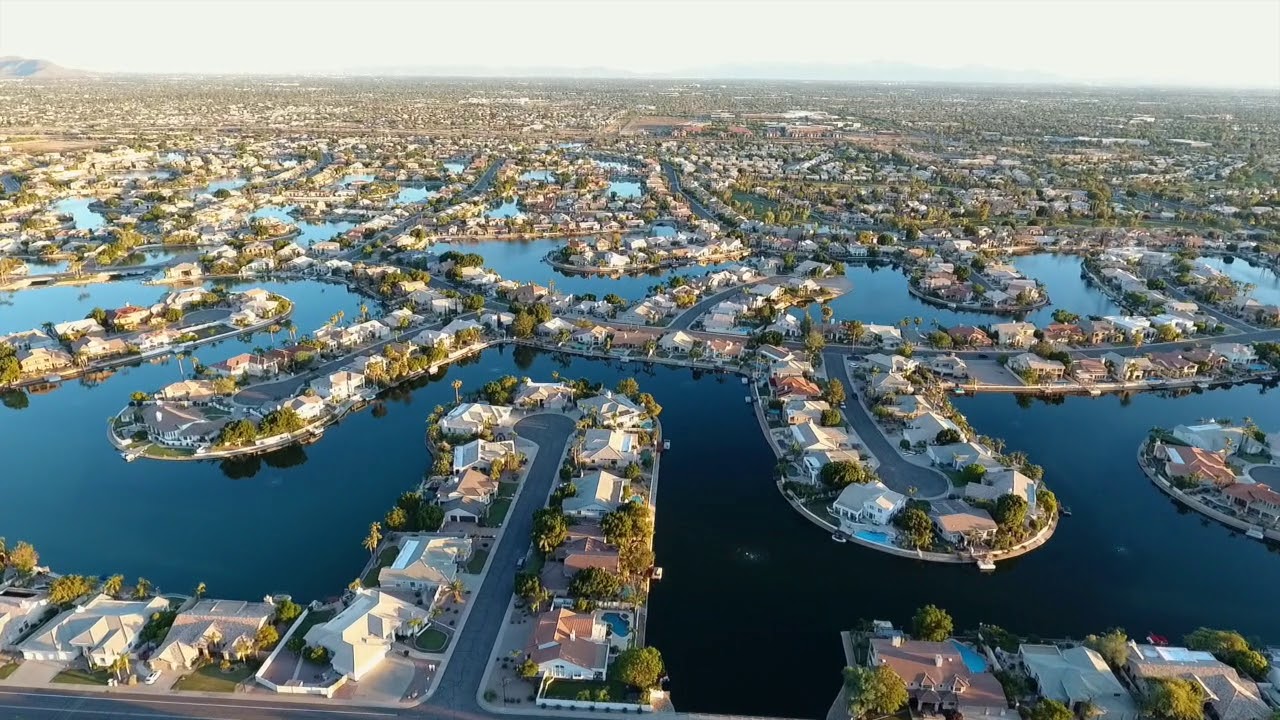
Phoenix Valley has more than 1400 artificial lakes — mostly in housing developments.
It wasn’t always this way.
Thousands of years ago, the Hohokam built 135 miles of canals and contoured the flat Valley into fields. But they died out — probably Small Pox (thank you Christopher Columbus).
The Pima, Maricopa and other tribes were farming in the region, when the US Army started building forts on the Verde and Salt Rivers.
Armies need food. Horses need hay. By 1867, white settlers like Jack Swilling (a former confederate soldier) moved in, did a little digging on the old Hohokam canals and started flooding the fields. He was not alone. A lot of displaced folks from the south came here, so Phoenix is closer in politics to Mississippi and Texas then California.
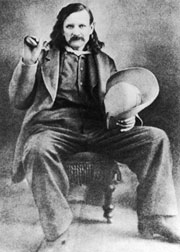
Just a few years later, in 1875, the Army killed nearly 100 Apaches in the Skeleton Cave Massacre, (the Army called it one of the biggest Apache “battles”). Then they force-marched the rest of the Apaches 100 miles east to the San Carlos reservation.
With those “troublesome neighbors” gone, the white folks mapped out the Valley into a grid pattern for 100 miles east-west and 45 miles north-south. Just to rub it in to the local tribes: The east and west streets were named after US presidents. Washington Street, Adams, Jefferson, Jackson, all got streets.
The north-south roads originally had Native American names, but fuck that. They changed it to numbers so people could remember it. Streets to the east, Avenues to the west — which is fucking confusing until you get used to it — then it seems like every city should be built that way.
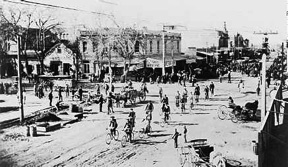
The Mormons moved into Mesa. The feds pushed the Salt River tribe into a reservation between the settlers in Phoenix on the west and the Mormons to the east. They found the Hohokam had built even better canals closer to the river. The Mormons mapped out the “East Valley” into a similar grid pattern with even wider streets and bigger fields for all. Leading to the tagline:
"Come to Mesa, where the streets are wide and the minds are narrow."
The freight trains came, and so did more people. They grew cotton and citrus. They built a street car — horses pulled at first – then it was electric.
Suburbs popped up in every direction far from Phoenix with their own small downtowns, water towers and train stops on the freight lines.
Arizona began a state. Eventually Phoenix wrestled the state capitol away from bigger cities like Prescott. Mostly because Phoenix was in the middle of the state, and people in Flagstaff and Tucson were not threatened by the tiny town that was hotter than hell (but not quite as hot as Yuma).
For a place that gets about 7-inches of rain a year, the biggest problem is “too much water”. When the snow melts or the summer thunderstorms came, the water easily escaped the river banks or edges of its wash and flooded any where it wanted over the flat Valley.
They dammed the Salt and Verde rivers into a string of narrow desert lakes. They dammed the Agua Fria River too. Lakes with no trees or undergrowth — perfect for motor boating and water skiing. (Phoenix has the highest number of boats per capita in the country). Dams meant a steady supply of water, flood control and cheap electricity.
WWII brought military bases and after the war, defense contractors and a flood of retirees fleeing the winter snow.
Bringing the Swamp to the Desert
At first they had swamp coolers — you know what that is? It’s a fan blowing air over a wet sponge. You get a big enough fan, a big enough sponge and a thousand gallons of cool water from 200 feet in the earth, you can get your house down to 75 degrees on a 105-degree day — in June.
In July, the monsoon humidity rolls in from Mexico. The swamp cooler will get the house to 85 degrees but you can see the water droplets building up like dew on the dry wall. You might as well bed down in the Amazon Rain Forest.
The 1950’s brought air conditioning to the masses. And they flocked to Phoenix by the tens of thousands. Cheap land, cheap homes. Water, sun and soil that can grow grass — especially in the winter – meant golf courses and resorts for rich from the industrial north could come play from Christmas to Easter. And the weathly from Chicago, Detroit and Minnesota “wintered” in the desert.
Baseball brought spring training, and half a dozen teams spend February and March playing fake games in front of sunburnt and half-drunk crowds in the middle of a weekday afternoon.
Regular folks could get jobs building golf courses, and housing. To power it all, they used a coal-fired plant on the Navajo Reservation north east of the Grand Canyon, and let the tribe and New Mexico deal with the air pollution. It’s only a little lung cancer — suck it up, wimps.
Cars for everybody. General Motors made sure the politicians got rid of the street cars. They paved over the tracks and built wide boulevards every mile.
Strip Malls and a Sea of Houses
Strip malls and a sea of housing developments sprawled over the farms as far as the eye could see. Low taxes, low development costs (no need for roads, schools or sewers — we’ll worry about that shit later), cheap loans and bankruptcy rules that exempt homes, fueled a boom and bust housing market that’s been going on for the last 70 years.
In the 60’s and 70’s, low taxes brought people from the east, midwest and even California. They settled in and voted against every initiative for schools, parks, hospitals and freeways.
The school system is regularly ranked among the worst in the country for funding. Lots of schools were little more than trailer parks, and teachers were paid less than carpenters. That pattern persists.
When the population passed 1 million and then 2 million, they finally passed some taxes to pay for sewers, water systems and drainage. But we are still playing catch up.
When the canal from the Colorado River came through in the 1980’s, the feds spent billions on drainage through the Phoenix Valley, so the floods would not wash away their new $15 billion canal.
That gave Phoenix even more access to water from even more states. And it literally paved the way to develop the northern half of the Valley, and the housing developments stretched halfway to Prescott.
They built a massive nuclear plant 50 miles west of downtown. It was one of the last nuclear plants built in the country.
No Burn Days
The cars brought the brown cloud. Dirty air, mostly during the winter, with incredibly high ozone levels, that clot up lungs and kill brain cells. That brought no burn days, so all the people who paid extra for fire places can never use them. But don’t worry, climate change and concrete has made the winters so warm, you don’t need a fucking fire anyway.
In the 90’s they finally funded freeways, so now you can loop around the Valley without ever hitting a stop light. But don’t try that during the day, the grid lock will have you sitting and breathing exhaust for hours at a time.
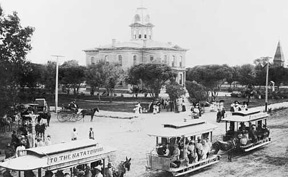
Original street car drawn by horse.
The 2000’s brought the light rail. That’s right 50 years after they paved over the street car, we are paying billions to rebuild it. Instead of being on every major thoroughfare, now we can only afford one thin line that snakes from the suburbs to the baseball stadium at 15 mph. The horses were almost that fast.
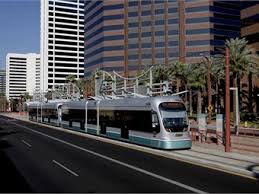
Like other American cities, Phoenix was conned into paying for a major league baseball stadium and an NFL stadium with tax dollars. In a climate where you can go outside every day of the year, they built massive roofs and air conditioning systems so they could play during TV primetime. In true Phoenix fashion, both have natural grass fields. But they learned with baseball, it’s hard as hell to grow grass in a canyon between the stadium walls.
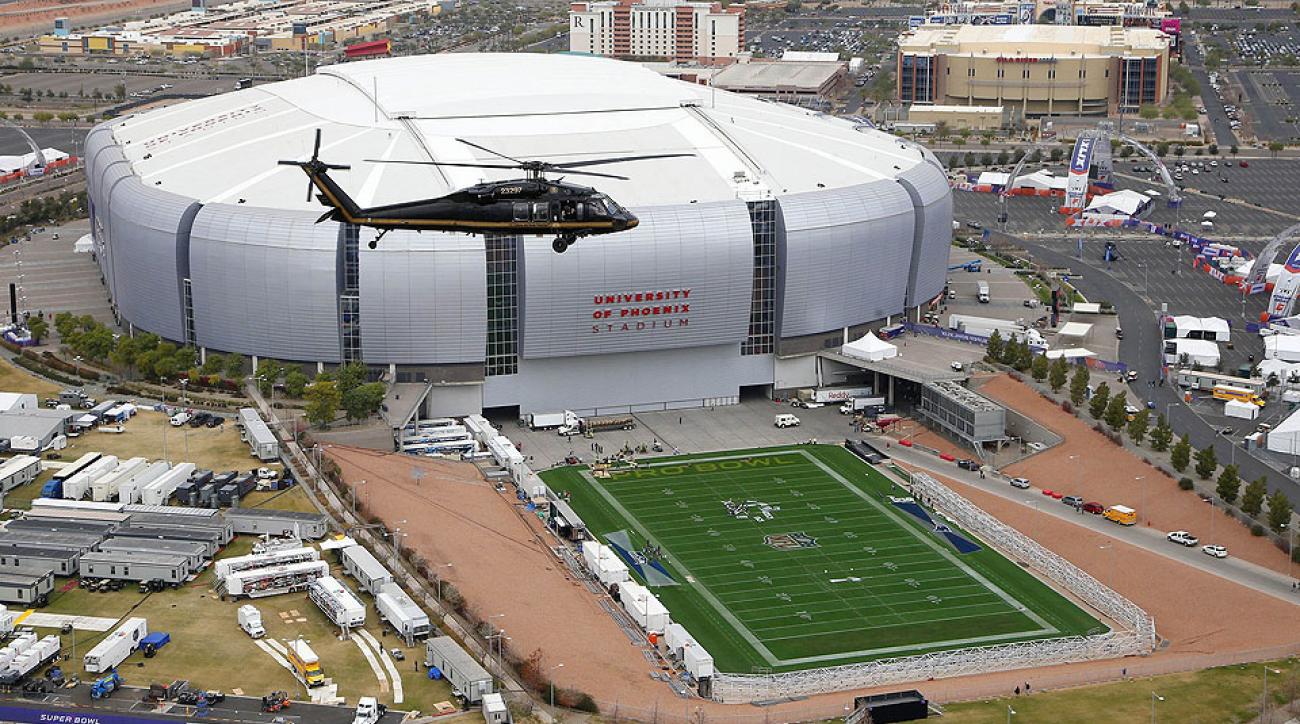
So the football stadium put the field on a conveyor belt. The field is in the parking lot soaking up the full sun. Game day they roll it into the building and crank up the AC, so we can watch grown men give each other brain damage at 1 O’clock on a Sunday afternoon. Awesome use of resources.
People wonder how the Valley can keep growing. But for every farm we plow over and cover with a Home Depot, 10-chain restaurants and 1000 houses, we cut the water use by 90 percent.
All the rivers are feeding the lake under the Valley, and the water table has been rising for the last 20 years. While the economy is willing, the people will keep coming.
Like the Hohokam before, this shit can’t last. We are at nearly 5 million in the Valley now, and somewhere there’s a limit to how many can live on 7 inches of rain a year.
And guess who holds most of the future water rights? What’s left of the local tribes. After battling over gambling rules, that eventually allowed the tribes to build casinos all around the Valley, the next fight was water. And in the early 2000’s most of the future water rights were granted back to the tribes. It only took a near extinction of their people and 100 years of lawsuits to get some of their water back.
So when the gambling binge ends, and the water starts running dry, the tribes will be able to manage who gets what water and when. Nice monopoly if you can get it.
The white folks are already growing grass and brewing beer from effulent. (That’s the left over shit water from the sewage plant), and as long as we keep sucking all the rivers dry from Colorado and Wyoming to Mexico, Phoenix can continue to grow. Eventually we will be touching LA and San Diego. Can’t wait to drive those commutes.
Categories: Phoenix Fables

I do know that there are seven Spanish angels in the valley of the sun. Well, there were, anyway.
LikeLiked by 1 person
At least Willie Nelson and Ray Charles thought so (had to google that one).
LikeLike
A football field on a conveyor belt? That says it all, concerning the Phoenician worship of grass. We worship grass in California, too, but it’s a tall sort of grass, with leaves. My wife and I briefly considered moving to Wickenburg a few years ago. But when we scouted it out, that town looked like it would burn to a crisp with just one errant throw of a spent cigarette. It also appeared to flood a lot.
And then, driving home on I-10, I spotted the Palo Verde nuclear power plant, which I understand is cooled by sewage from Phoenix. It seems the prevailing wind from the Southwest would carry a toxic radiation cloud straight to the Valley of the Sun, in the event of a meltdown. I worry that Phoenix could easily become a future Chernobyl. So we decided to stay in California.
Great write-up. I love your raw language and straight-up information, with no punches pulled. If only our history books in school were written in this fashion.
LikeLiked by 1 person
Thanks. Most of the water in Phoenix is sewage. Here’s my favorite example of that… https://kieranbullshit.com/2017/04/08/revenge-through-plumbing/ And we are probably a future Chernobyl.
LikeLike
Oh God, that is hilarious. I’m sure glad I discovered your blog. I’ve got some exploring to do.
And maybe there’s one consolation to Sheriff Joe being pardoned. You still get to shit on him every year, and be thanked for it.
LikeLiked by 1 person
Thanks. It’s only funny because it’s true. You read fast.
LikeLiked by 1 person
I read fast ’cause I’ve got the smartz. Some of my followers may not think so, but I think fast reading proves that I do.
LikeLiked by 1 person
K-Man,
What a great example of how we waste everything. This write up is great. That whole part about the light rail coming back after the original line was destroyed -unbelievable!
A field on a conveyer belt?! WTF! I dont even know how to imagine what things will look like in 50 years. Probably wont be around to see it -maybe for the best. Maybe like Mars only with cool golf courses for the rich.
-Butterpants
LikeLiked by 1 person
I worked in an old office building in Phoenix that had a map of the original streetcar. A line on every major street for every mile in every direction in “downtown.” They ripped it out to make more room for cars. Thanks Exxon and General Motors for lobbying against public transit…
LikeLike
This kind of absurdity could make a thinking man angry. Good thing im a knuckle dragging boozehound.
Hand me down a beer
-Butterpants
LikeLiked by 1 person